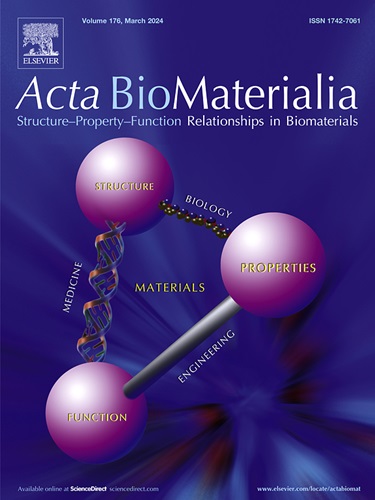Multifunctional porous organic polymer-based hybrid nanoparticles for sonodynamically enhanced cuproptosis and synergistic tumor therapy
IF 9.4
1区 医学
Q1 ENGINEERING, BIOMEDICAL
引用次数: 0
Abstract
Cuproptosis has gained significant attention among different cell death pathways in cancer therapy, which relies on the excessive accumulation of Cu2+ in mitochondria of tumor cells. Nevertheless, the high levels of glutathione in tumor microenvironment chelates with Cu2+ and thereby reducing its cytotoxicity. In this study, we designed core-shell porous organic polymers (POPs) nanoparticles to deliver and accumulate Cu2+ in tumor cells for enhanced cuproptosis. The porous organic polymers, containing bipyridine structural units, were synthesized on the aminated silica template, followed by the coordination of Cu2+ and the loading of artesunate (ART) as the sonosensitizer, yielding the Cu/ART@Hpy nanoparticles. In the acidic tumor microenvironment, the nanoparticles realized pH-responsive release of Cu2+. Meanwhile, the generation of ROS under ultrasound irradiation depleted intracellular glutathione, leading to the increased intracellular accumulation of Cu2+ for cuproptosis and triggering multiple cell death mechanisms for sonodynamically enhanced tumor therapy. Our study highlights the potential of the porous organic polymer as a platform for cuproptosis and synergistic tumor therapy.
Statement of significance
Cuproptosis is induced by the excessive accumulation of Cu²⁺ within the mitochondria of tumor cells. However, the high level of glutathione in the tumor microenvironment can chelate Cu²⁺, thereby reducing the therapeutic efficacy. In this study, we developed the core-shell structured Cu/ART@Hpy nanoparticles for pH-responsive delivery of Cu²⁺. Under ultrasound irradiation, the generated reactive oxygen species deplete intracellular glutathione, enhancing Cu²⁺ accumulation for cuproptosis and activating multiple cell death pathways. The Cu/ART@Hpy nanoparticles enable sonodynamically enhanced cuproptosis, achieving synergistic tumor therapy.

多功能多孔有机聚合物基杂化纳米粒子用于声动力增强铜增生和协同肿瘤治疗。
cuprotosis依赖于肿瘤细胞线粒体中Cu2+的过度积累,在癌症治疗的不同细胞死亡途径中受到了极大的关注。然而,肿瘤微环境中高水平的谷胱甘肽与Cu2+螯合,从而降低其细胞毒性。在这项研究中,我们设计了核-壳多孔有机聚合物(POPs)纳米颗粒,用于在肿瘤细胞中传递和积累Cu2+,以增强cuproprosis。在胺化二氧化硅模板上合成了含有联吡啶结构单元的多孔有机聚合物,然后将Cu2+配位并负载青蒿琥酯(ART)作为声敏剂,得到Cu/ART@Hpy纳米颗粒。在酸性肿瘤微环境中,纳米颗粒实现了Cu2+的ph响应释放。同时,超声照射下ROS的产生使细胞内谷胱甘肽耗竭,导致细胞内Cu2+积累增加,导致cuproposis,触发多种细胞死亡机制,用于声动力增强肿瘤治疗。我们的研究强调了多孔有机聚合物作为铜增生和协同肿瘤治疗平台的潜力。意义声明:cu2 +是由肿瘤细胞线粒体内Cu 2 +的过度积累引起的。然而,肿瘤微环境中高水平的谷胱甘肽会螯合Cu 2 +,从而降低治疗效果。在这项研究中,我们开发了核壳结构的Cu/ART@Hpy纳米颗粒,用于ph响应递送Cu 2 +。超声照射下,生成的活性氧耗尽细胞内谷胱甘肽,增强cu2 +在铜还原中的积累,激活多种细胞死亡途径。Cu/ART@Hpy纳米颗粒可实现声动力增强的铜增生,实现协同肿瘤治疗。
本文章由计算机程序翻译,如有差异,请以英文原文为准。
求助全文
约1分钟内获得全文
求助全文
来源期刊

Acta Biomaterialia
工程技术-材料科学:生物材料
CiteScore
16.80
自引率
3.10%
发文量
776
审稿时长
30 days
期刊介绍:
Acta Biomaterialia is a monthly peer-reviewed scientific journal published by Elsevier. The journal was established in January 2005. The editor-in-chief is W.R. Wagner (University of Pittsburgh). The journal covers research in biomaterials science, including the interrelationship of biomaterial structure and function from macroscale to nanoscale. Topical coverage includes biomedical and biocompatible materials.
 求助内容:
求助内容: 应助结果提醒方式:
应助结果提醒方式:


